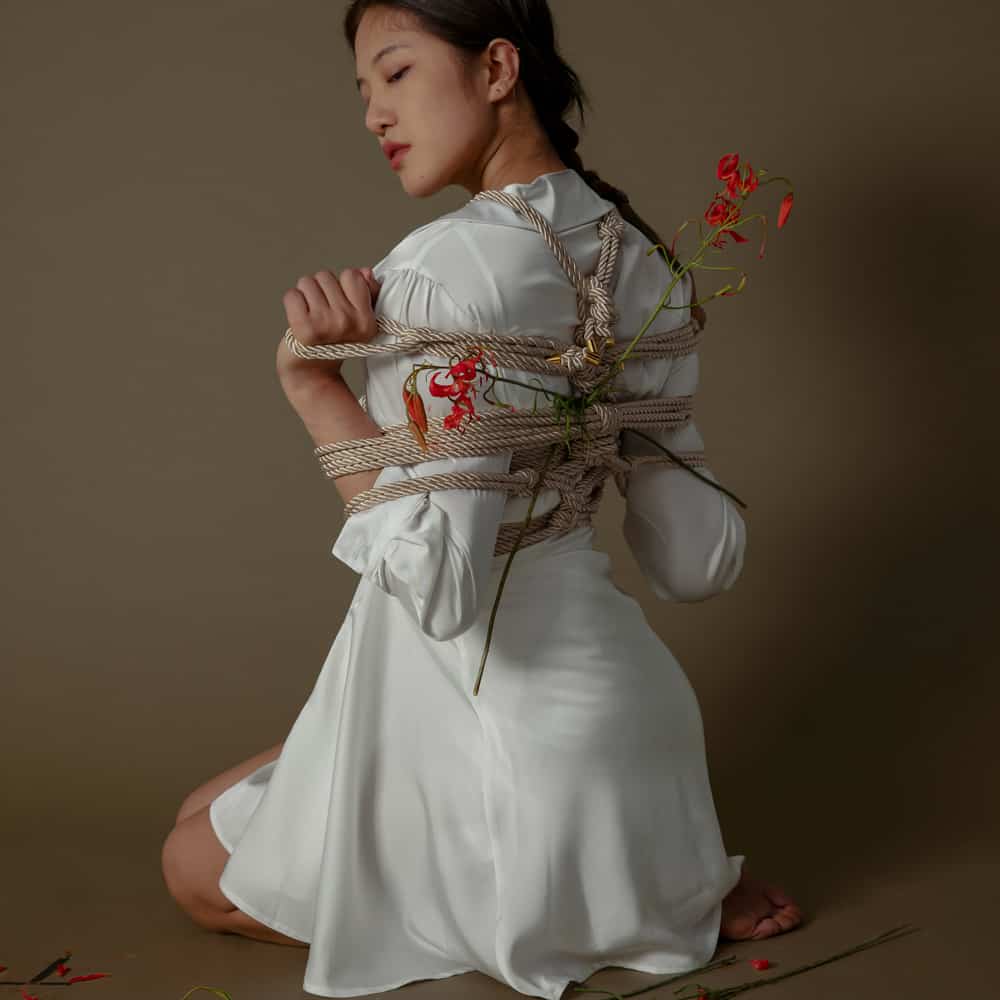Welcome to the fascinating world of Shibari, an ancient Japanese art form that transforms rope into a medium for beauty, connection, and self-expression. If you’re new to Shibari, you might be curious, maybe even a little intimidated, but don’t worry this guide is here to walk you through everything you need to know as a beginner. From its rich history to practical tips for tying your first knot, we’ll explore Shibari with warmth, clarity, and a human touch. Let’s dive in! 🌸
This article is designed to be approachable, authentic, and packed with insights to help you start your Shibari journey safely and confidently. We’ll cover the cultural roots, essential techniques, safety practices, and emotional aspects of this intimate practice all while keeping it engaging and real. Ready? Let’s get started! 😊
What Is Shibari? Understanding the Art and Its Essence 🎨

Shibari, often referred to as Japanese rope bondage, is a practice that combines aesthetics, technique, and emotional connection through the art of tying ropes. The word Shibari comes from the Japanese verb shibaru, meaning “to tie” or “to bind.” While it’s sometimes associated with BDSM, Shibari is much more than a kinky bedroom activity it’s a meditative, creative, and deeply connective practice rooted in Japanese culture.
At its core, Shibari is about creating beautiful patterns with rope on the human body, emphasizing symmetry, balance, and harmony. It’s like painting with ropes, where the body becomes the canvas and the knots become the brushstrokes. 🖌️ For beginners, it’s important to understand that Shibari isn’t just about the physical act of tying it’s about trust, communication, and the shared experience between the person tying (the rigger) and the person being tied (the model or bottom).
A Brief History of Shibari 📜
Shibari’s origins trace back to Japan’s Edo period (1603–1868), where ropes were used in hojojutsu, a martial art for restraining prisoners with intricate knot techniques. These methods were not only functional but also carried a sense of honor and aesthetics, as the way a prisoner was tied reflected the captor’s skill and status.
Fast forward to the 20th century, Shibari evolved into an erotic and artistic practice, influenced by Japanese theater and performance art. Pioneers like Seiu Ito, a photographer and artist, began exploring rope as a medium for sensual expression, blending beauty with restraint. Today, Shibari has spread globally, embraced by artists, performers, and everyday enthusiasts who appreciate its blend of creativity and intimacy. 🌍
For beginners, knowing this history helps you appreciate Shibari as more than a trend it’s a cultural practice with deep roots, deserving respect and mindfulness. 🙏
Why Try Shibari? The Benefits for Beginners 🌟

You might be wondering, Why should I try Shibari? Great question! Shibari offers a unique blend of physical, emotional, and creative benefits that make it appealing to newcomers. Here are some reasons why you might want to give it a go:
- Deepens Connection 🤝
Shibari requires trust and communication between partners, whether romantic or platonic. The act of tying and being tied fosters vulnerability and intimacy, strengthening your bond. - Boosts Creativity 🎭
Tying knots and creating patterns is like solving a puzzle or choreographing a dance. It sparks your imagination and lets you express yourself artistically. - Promotes Mindfulness 🧘♀️
Shibari is meditative. The focus on each knot, the rhythm of the rope, and the awareness of your partner’s body can feel like a moving meditation, grounding you in the moment. - Empowers Body Positivity 💖
Shibari celebrates all bodies. The ropes accentuate curves, lines, and shapes, helping you and your partner appreciate your bodies in new ways. - Explores Trust and Vulnerability 🔒
For the person being tied, surrendering control can be liberating. For the rigger, the responsibility of caring for their partner builds confidence and empathy.
As a beginner, you don’t need to dive into complex ties or intense scenes right away. Start small, and you’ll discover how Shibari can enrich your relationships and self-awareness. 😊
Getting Started: What You Need to Begin 🛠️
Before you tie your first knot, let’s gather the essentials. Shibari doesn’t require a ton of gear, but having the right tools and mindset is crucial for a safe and enjoyable experience. Here’s what you’ll need:
1. The Right Rope 🪢
Rope is the heart of Shibari, and choosing the right one is key. For beginners, here are some tips:
- Material: Natural fiber ropes like jute or hemp are traditional for Shibari. They’re strong, have good grip, and feel authentic. Cotton is a softer, more affordable option for beginners but less durable.
- Length: Start with 3–5 ropes, each 7–10 meters (23–33 feet) long. This gives you enough to work with for basic ties.
- Diameter: 6mm is the standard for Shibari it’s strong yet flexible. Thinner ropes (4mm) are for decorative ties, while thicker ones (8mm) are for suspension (not for beginners!).
Pro Tip: Buy from reputable Shibari retailers or check reviews to ensure quality. Avoid synthetic ropes like nylon for now they’re slippery and harder to control. 🛑
2. Safety Tools ✂️
Safety is non-negotiable in Shibari. Always have:
- Safety Shears: These are blunt-tipped scissors designed to cut rope quickly in an emergency. Keep them within reach during every session.
- First Aid Kit: For minor rope burns or unexpected injuries.
- Communication Plan: Agree on verbal and non-verbal safewords (e.g., “Red” to stop, a double-tap if gagged).
3. A Learning Mindset 📚
Shibari is a skill that takes time to master. Approach it with curiosity, patience, and a willingness to learn. Mistakes are part of the process, so don’t stress about perfection. 😅
4. A Partner or Practice Space 🤗
You can practice Shibari solo (self-tying) or with a partner. If you’re working with someone, ensure they’re enthusiastic and consenting. Create a calm, private space with soft lighting and a comfortable surface (like a yoga mat or bed).
Safety First: The Golden Rules of Shibari 🛡️

Shibari is beautiful, but it’s not without risks. As a beginner, prioritizing safety ensures everyone has a positive experience. Here are the golden rules to follow:
1. Consent Is Everything 🙌
- Explicit Consent: Everyone involved must fully understand and agree to the activity. Discuss boundaries, limits, and desires beforehand.
- Ongoing Consent: Check in during the session. Consent can be withdrawn at any time, and that’s okay. Use safewords to communicate clearly.
- Aftercare: Plan for aftercare cuddling, talking, or hydrating to help everyone process the experience emotionally and physically.
2. Know Your Anatomy 📖
Ropes can put pressure on nerves, joints, and blood vessels, so avoid:
- Nerve Compression: Don’t tie tightly around wrists, elbows, or knees, where nerves are close to the surface.
- Circulation Issues: Check for numbness, tingling, or cold skin. If you notice these, loosen or remove the ropes immediately.
- Breathing Restrictions: Never tie ropes tightly across the chest or diaphragm in a way that restricts breathing.
Pro Tip: Take a basic anatomy workshop or read up on nerve pathways to tie safely. Knowledge is power! 💪
3. Start Simple and Slow 🐢
- Begin with basic ties like the single-column or double-column tie (we’ll cover these later). Avoid suspension or complex patterns until you’re experienced.
- Check tension regularly. Ropes should be snug but not painful. If your partner says it’s too tight, adjust immediately.
4. Never Leave Someone Tied Alone 🚨
Never leave a tied-up person unattended, even for a moment. They could lose balance, panic, or experience a medical issue, and you need to be there to help.
5. Practice Emergency Protocols 🩺
- Know how to untie knots quickly. Practice untying under pressure.
- Keep safety shears handy to cut ropes if needed. Don’t hesitate to use them in an emergency rope is replaceable, people aren’t.
By following these rules, you’ll create a safe space for exploration and creativity. Safety isn’t just a checklist; it’s a mindset that builds trust. 🌈
Your First Ties: Basic Shibari Techniques for Beginners 🪡

Now for the fun part tying your first knots! These beginner-friendly ties are simple, safe, and versatile. They’ll help you build confidence and get a feel for the ropes. Grab your rope and let’s get started! 😄
1. The Single-Column Tie 🏛️
The single-column tie is the foundation of many Shibari patterns. It’s used to tie a single “column” (like a wrist, ankle, or thigh) securely without cutting off circulation.
How to Do It:
- Prepare the Rope: Fold your rope in half to find the midpoint (the “bight”). Place the bight against the wrist or ankle.
- Wrap the Rope: Wrap the rope around the limb twice, keeping it flat and snug but not too tight.
- Cross and Twist: Bring the working ends (the loose ends) over the bight and twist them to form a loop.
- Secure the Knot: Pass the working ends through the loop and pull gently to tighten. Ensure you can fit two fingers between the rope and skin.
- Finish: Tie a simple square knot to lock it in place. Check for comfort and adjust if needed.
Uses: This tie is perfect for securing a wrist to a bedpost or creating a starting point for more complex patterns.
2. The Double-Column Tie ⚖️
This tie connects two limbs (e.g., both wrists or ankles) together, maintaining symmetry and balance.
How to Do It:
- Position the Limbs: Place the wrists or ankles side by side, about 2–3 inches apart.
- Start with a Single-Column Tie: Wrap the rope around one limb as described above, but don’t finish the knot yet.
- Connect the Second Limb: Wrap the rope around the second limb, mirroring the first wrap.
- Tie Off: Pass the working ends through the bight of the first tie, pulling to connect both limbs. Finish with a square knot.
- Check Tension: Ensure the limbs are secure but not squeezed together. Adjust for comfort.
Uses: Great for binding wrists behind the back or ankles together for a simple restraint.
3. The Basic Chest Harness 💝
A chest harness is a decorative and functional tie that frames the upper body beautifully. It’s a bit more advanced but doable for beginners with practice.
How to Do It:
- Start at the Back: Fold the rope in half and place the bight at the center of the upper back, just below the shoulders.
- Wrap the Chest: Bring the working ends forward, under the arms, and wrap around the chest above the breasts (or at mid-chest for all bodies). Pull back to the bight.
- Create a Second Wrap: Wrap the rope around the chest again, this time below the breasts or lower on the chest. Pull snugly to the back.
- Secure at the Back: Tie a square knot at the bight to lock the harness in place.
- Add Decorative Knots (Optional): For a prettier look, add a few overhand knots along the ropes at the front.
Uses: This harness is both aesthetic and a foundation for more complex ties. It’s great for building trust and creating a sense of embrace.
Pro Tip: Practice these ties on a chair leg or your own ankle first to get the motions down. When tying a partner, move slowly and check in often. 😊
Building Trust and Communication: The Emotional Side of Shibari 🤗
Shibari isn’t just about ropes it’s about the people involved. The emotional connection between the rigger and the model is what makes Shibari so special. Here’s how to nurture that connection as a beginner:
1. Pre-Session Communication 🗣️
Before you touch a rope, have an open conversation with your partner. Discuss:
- Experience Level: Are you both new to Shibari? Any prior rope experience?
- Comfort Zones: What areas of the body are okay to tie? Any no-go zones?
- Emotional Needs: Does your partner want to feel empowered, relaxed, or vulnerable? What’s the mood you’re aiming for?
- Physical Limits: Any injuries, medical conditions, or flexibility concerns?
This chat sets the tone for trust and ensures everyone’s on the same page. 📋
2. Checking In During the Session 👀
While tying, keep the communication flowing:
- Verbal Check-Ins: Ask, “How does this feel?” or “Is this okay?” every few minutes.
- Non-Verbal Cues: Watch for signs of discomfort, like tense muscles or shallow breathing. If your partner can’t speak (e.g., gagged), use a non-verbal safeword like a hand signal.
- Adjust as Needed: If something feels off, pause and adjust. There’s no rush Shibari is about the journey, not the destination. 🛤️
3. Aftercare: The Post-Session Hug 🥰
After untying, spend time on aftercare to process the experience:
- Physical Care: Offer water, a blanket, or a snack to help your partner feel grounded.
- Emotional Care: Talk about the session. What felt amazing? Anything to change next time? Sometimes, just cuddling in silence is perfect.
- Check for Marks: Rope can leave temporary marks or burns. Check the skin and apply lotion if needed.
Aftercare is a beautiful way to show care and deepen your connection. It’s like the dessert after a delicious Shibari meal! 🍰
Common Mistakes and How to Avoid Them 🙈
As a beginner, you’re bound to make a few missteps and that’s okay! Here are some common pitfalls and how to steer clear:
- Tying Too Tight 🥴
Mistake: Over-tightening ropes can cause pain or nerve damage.
Fix: Always check tension. You should be able to slip two fingers under the rope. Practice loosening knots quickly. - Skipping Safety Checks 🚩
Mistake: Forgetting to have shears or safewords ready.
Fix: Create a safety checklist and review it before every session. Keep tools within arm’s reach. - Rushing the Process 🏃♂️
Mistake: Trying complex ties or rushing through knots to “get it done.”
Fix: Slow down. Shibari is about the experience, not the end result. Master basic ties first. - Ignoring Emotional Needs 😢
Mistake: Focusing only on technique and neglecting your partner’s feelings.
Fix: Prioritize communication and aftercare. Check in emotionally before, during, and after. - Using Poor-Quality Rope 🧵
Mistake: Cheap or synthetic ropes can fray, slip, or cause burns.
Fix: Invest in quality jute or hemp from trusted suppliers. It’s worth it for safety and aesthetics.
Learning from mistakes is part of the journey. Laugh them off, adjust, and keep going! 😄
Growing Your Shibari Skills: Next Steps for Beginners 🌱
Once you’re comfortable with basic ties, you’re ready to level up! Here’s how to keep growing as a Shibari enthusiast:
1. Take a Workshop or Class 📚
- Look for local or online Shibari workshops led by experienced riggers. Many communities offer beginner-friendly classes that cover technique, safety, and etiquette.
- Online platforms like YouTube or Shibari-specific websites (e.g., The Duchy or Shibari Academy) have tutorials, but choose reputable sources to avoid bad habits.
2. Join a Shibari Community 🤝
- Connect with other rope enthusiasts through local meetups, munches (casual BDSM gatherings), or online forums like FetLife or Reddit’s r/Shibari.
- Communities offer support, inspiration, and a chance to learn from others’ experiences. Plus, it’s fun to geek out over knots! 😜
3. Practice Regularly 🏋️♀️
- Set aside time each week to practice knots, even if it’s just tying a single-column tie on a chair. Muscle memory is key.
- If you have a partner, schedule rope dates to experiment and bond. Keep it playful and low-pressure.
4. Explore Aesthetics 🎨
- Shibari is an art form, so play with patterns, colors, and symmetry. Try tying with different rope colors or adding decorative knots.
- Study photos of traditional Shibari ties for inspiration, but don’t feel pressured to replicate them perfectly.
5. Stay Curious and Humble 🧠
- Shibari is a lifelong learning process. Even experts are always refining their skills.
- Read books like The Seductive Art of Japanese Bondage by Midori or Shibari You Can Use by Lee Harrington for deeper insights.
The key is to enjoy the journey. Every knot you tie is a step toward mastery! 🚀
Shibari Myths Busted: Setting the Record Straight 🕵️♀️
As a beginner, you might encounter myths or misconceptions about Shibari. Let’s clear up a few:
- Myth: Shibari is always sexual.
Truth: While Shibari can be erotic, it’s often non-sexual, focusing on art, connection, or meditation. It’s whatever you make it! 🌈 - Myth: You need to be super flexible or fit.
Truth: Shibari is for all bodies and flexibility levels. Start with ties that suit your comfort and mobility. - Myth: Shibari is dangerous and risky.
Truth: With proper safety practices and communication, Shibari is as safe as any physical activity. Education is key. 🛡️ - Myth: You need expensive gear to start.
Truth: A few quality ropes and safety shears are enough for beginners. No fancy dungeon required! 😅 - Myth: Shibari is only for couples.
Truth: You can practice solo, with friends, or in performance settings. It’s versatile and inclusive.
Busting these myths helps you approach Shibari with an open mind and realistic expectations. 🙌
FAQs: Answering Your Beginner Questions ❓
Here are some common questions beginners ask about Shibari, with answers to keep you confident:
Q: How long does it take to learn Shibari?
A: Basic ties can be learned in a few hours, but mastering Shibari takes months or years. Focus on enjoying the process rather than rushing to expertise. 🕰️
Q: Can I practice Shibari alone?
A: Yes! Self-tying is a great way to learn knots and explore the feel of ropes. Just follow safety rules and avoid risky ties. 🪢
Q: What if my partner isn’t into Shibari?
A: Respect their boundaries. You can explore solo or find a platonic rope partner in a community setting. Consent is everything. 🤝
Q: How do I deal with rope burns or marks?
A: Minor rope marks are normal and usually fade in a day or two. Apply aloe vera or lotion and avoid tight ties in the same spot for a while. 🩹
Q: Is Shibari culturally appropriative?
A: Shibari is a Japanese practice, so approach it with respect for its cultural roots. Learn its history, support Japanese artists, and avoid reducing it to a trend. 🙏
Got more questions? Join a community or ask an experienced rigger. There’s always more to learn! 📖
Final Thoughts: Embrace Your Shibari Journey 🌟

Congratulations you’ve just taken your first steps into the captivating world of Shibari! 🪢 This art form is as much about the heart as it is about the hands. By starting with safety, communication, and simple ties, you’re building a foundation for a rewarding practice that can bring joy, connection, and creativity into your life.
As you move forward, remember to:
- Stay Safe: Prioritize consent, communication, and proper technique.
- Be Patient: Every knot is a learning opportunity. Embrace the process.
- Have Fun: Shibari is about exploration and expression. Let your curiosity lead the way. 😊
Whether you’re tying for art, intimacy, or mindfulness, Shibari is a journey worth taking. So grab your ropes, connect with your partner (or yourself), and start creating something beautiful.
Here’s to your Shibari adventure! 🎉

